Iran Sentences Prominent Filmmaker to Six Months In Prison
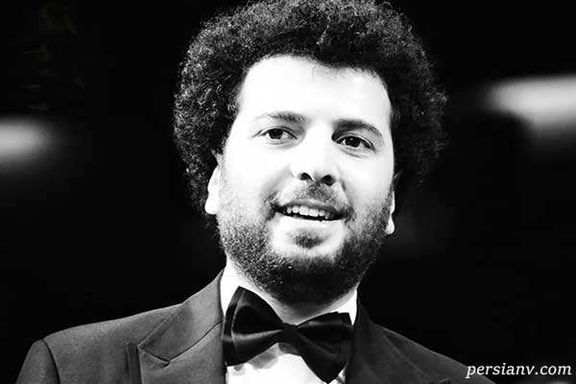
Renowned Iranian filmmaker Saeed Roustayi has been sentenced to six-month in prison on charges of "anti-regime propaganda activity".

Renowned Iranian filmmaker Saeed Roustayi has been sentenced to six-month in prison on charges of "anti-regime propaganda activity".
The regime handed down these charges after Roustayi’s defied their explicit objections to allow his film ‘Leila's Brothers’ to be screened at Cannes Film Festival, Etemad Online revealed.
Roustayi will serve a preliminary portion equivalent to one-twentieth of his total sentence, while the remaining term will be suspended for five years. During this suspension, he is bound to refrain from any pursuits associated with the alleged offense, discontinue associations with fellow filmmaking professionals, and successfully complete a specialized curriculum at the state TV's university, in the religious city of Qom. This curriculum will focus on "filmmaking while preserving national and ethical interests."
‘Leila's Brothers’, which gives an insight into Iranian society through a complex family saga, was selected for the 2022 Cannes Film Festival Competition section, where it won the Citizen’s Award and the Prix FIPRESCI, chosen by The International Federation of Film Critics. It was also nominated for the distinguished Palme d'Or accolade.
Recognized for his thought-provoking cinematic narratives that explore themes of societal disparity and his nuanced portrayals of women within Iranian society, Roustayi's artistic endeavors have garnered widespread admiration and commendation.
Last November, The House of Cinema, Iran's professional film association, compiled a list of 100 filmmakers as well as other movie, music and theater personalities who have been either arrested or banned from work amidst nationwide anti-government protests. Such reports underscore the increasingly difficult and severe restrictions, which impede the work of creative professionals.

Journalist Nazila Maroufian, who was released on bail just days ago, has been arrested again and detained in Qarchak prison.
The journalist, who is also a student at Allameh Tabatabai University in Tehran, was arrested in July following a summons to the Prosecutor's Office at Evin prison.
After being released on bail on Sunday, she went to a police station to retrieve her mobile phone and was allegedly attacked by law enforcement officers. A witness reported that an officer struck Maroufian on the back of her head. Maroufian’s mother, who was with her, compared her daughter's treatment to the tragic case of Mahsa Amini, who died while in the custody of the morality police. The officer replied, "Yes, just like we killed her, we will kill this one as well."
Both mother and daughter were arrested and detained although Maroufian's mother was later released. The journalist herself was transferred to a quarantine ward within Qarchak prison, south of Tehran, based on a temporary arrest warrant.
Her initial arrest came after security agents from the Ministry of Intelligence raided Maroufian's home and summoned her to the prosecutor's office.
Maroufian was previously employed by the moderate Iranian news website Rouydad 24, which had been a reliable source of news about developments in Iran. In March, the Iranian regime temporarily blocked access to the website after it published an interview with Amjad Amini, the father of Mahsa (Zina) Amini.

Russia has ceased its gasoline exports to Iran for the past few months, an informed Iranian oil ministry official told Iran International on Monday.
The source said the Ministry had intended to import up to 10 million liters of gasoline daily from Russia to compensate for the gap in gasoline production and consumption. However, the Russian authorities, aware of Iran's needs, have halted the sale of gasoline to Iran, disrupting the planned efforts to address the fuel deficit. The expected volume from Russia would constitute roughly 10 percent of Iran's daily consumption in 2022.
The shortage has led to reductions in gasoline shipments to gas stations and long lines forming with cars rushing to fill their tanks.
According to the source, several other Commonwealth of Independent States (CIS) countries have also been pushed by Moscow not to sell gasoline to Iran, further compounding the challenges faced by Iran. The CIS is a regional intergovernmental organization in Eurasia, formed following the dissolution of the Soviet Union in 1991.
One possible explanations could be Moscow's desire to raise the price of its gasoline, amid serious financial and economic challenges it faces following its invasion of Ukraine. Russia's currency the ruble fell again on Monday against the US dollar, breaking the psychological barrier of 100 rubles per dollar.
After Western countries slashed energy imports from Russia, Moscow started exporting gasoline and diesel to Iran by rail this year for the first time since it lost its traditional customers. In February and March, Russia supplied up to 30,000 tons of gasoline and diesel to Iran, Reuters reported.
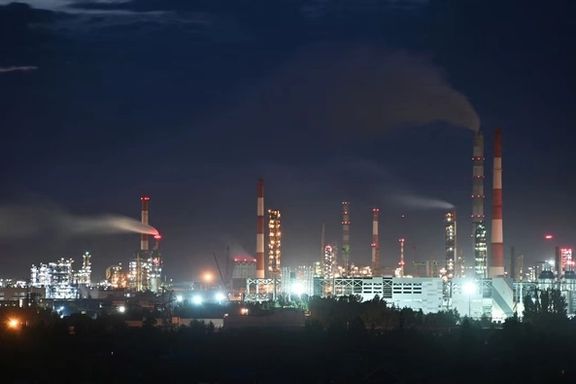
Subsequently, Ahmad Maroufkhani, the head of Iranian Oil, Gas and Petrochemical Products Exporters' Union, disclosed that Iran was procuring each ton of petroleum products from Russia at a price $150 higher than global market rates. He told Tajaarat News that in addition to Russia Turkmenistan and Uzbekistan had also supplied fuel this year. According to Reuters, the shipments were made by rail from Russia via Kazakhstan and Turkmenistan.
Iran has been struggling with gasoline shortages since at least the beginning of the summer of 2022 and was forced to release one-third of its strategic gasoline reserves by the end of the same year. A source at the oil ministry told Iran International Sunday that the National Iranian Oil Refining and Distribution Company (NIORDC), a department within the ministry, has released around 900 million liters of strategic gasoline reserves into the market in an effort to make up the deficit. Iran has also scaled back its distribution, announced as a needed step to curb smuggling, limiting each refueling session to only 30 to 40 liters.
Earlier in the month, NIORDC deputy manager Ali Ziyar said that the average daily consumption of gasoline has hit 124 million liters, indicating a 20-percent increase compared with the previous year. “In recent years, the maximum annual growth in gasoline consumption has been seven percent, but this year we have suddenly experienced a 20 percent increase in consumption,” he said, tacitly acknowledging that a large amount of fuel is being smuggled out of the country because it is much cheaper than Iran’s neighboring countries. He also stated that the daily gap between production and consumption is 17 million liters.
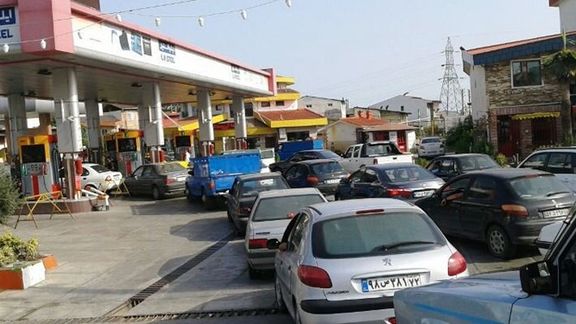
In recent days, rumors of an impending gasoline price increase have once again ignited, prompting a rush to gas stations. One of the main reasons that the Islamic Republic has not increased prices is because a fuel price hike would risk another wave of protests and strikes across Iran, especially with the first anniversary of Mahsa Amini’s death in police custody -- the starting point of the ‘Women, Life, Liberty’ movement on the horizon.
Reza Ghorashi, a professor of Economics at Stockton University in the US, told Iran International that a large strike by the fuel truck drivers amid tensions over prices can cripple the regime’s economy. He said in addition to economic repercussions, such an action is also a bold political statement in support of the popular street protests. Truckers, who do the heavy lifting of transporting goods mainly to and from Iran’s border areas and ports across the country, have already held several rounds of weeks-long strikes that brought the flow of goods and the supply chain to a grinding halt.
An military ally of Russia providing drones and missiles, the Iranian regime is also involved in a bitter confrontation with the West. Iran and Russia’s alliance may prove to be very flimsy as both countries are grappling with Western sanctions that and further economic woes for their people.
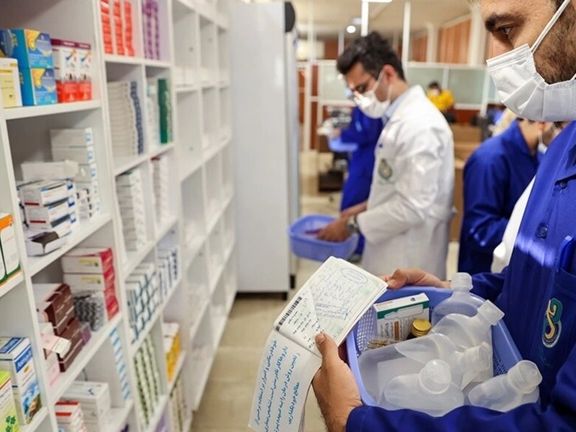
In a recent surge of repression against the Baha'i community Iranian security have arrested nine citizens in Tehran and closed 40 drugstores and warehouses owned by Baha’is.
The Ministry of Intelligence of the Islamic Republic divulged details in a formal statement on Sunday, revealing the nature of the arrests. "The detained Baha'i family and their accomplices were engaged in the realm of medicines and cosmetics, " according to the Ministry.
Baha'i activists shared additional insights with Radio Farda, the Persian Service of Radio Free Europe in Prague, identifying those affected by the crackdown. These sources indicated that the Ministry of Intelligence agents conducted visits to the Tabibian family's pharmacies and warehouses, during which, they also confiscated communication devices belonging to some employees.
The ministry cited various accusations against the detained individuals, including "drug smuggling and hoarding, money laundering, and tax evasion." As a result, the security agency reported the seizure of "20 pharmacies and 3 cosmetics companies and warehouses" linked to the Tabibian family. Usually in such cases seized assets end up in the hands of regime organizations and insiders.
Over the years, the Islamic Republic's security entities have subjected adherents of the Baha'i faith to undue pressure, often under the pretext of security concerns. These actions have frequently culminated in the confiscation or seizure of their properties.
The ongoing plight of Baha'is in Iran continues to raise international concerns. Presently, three members of Yaran-e Iran, a Baha’i community group remain incarcerated under security-related orders.
The Islamic Republic of Iran refuses to acknowledge the Baha'i faith, and the followers of this religion have been subjected to extensive restrictions and hardships since 1979.
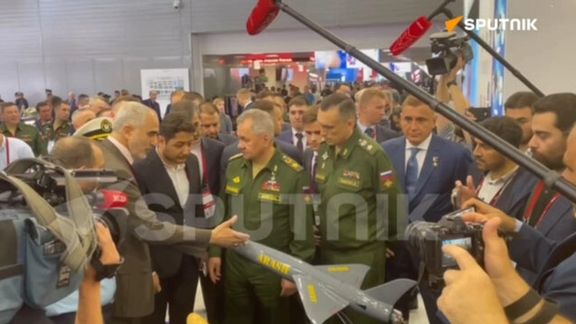
Russian Defense Minister Army General Sergey Shoigu visited the military stands of several countries, including Iran’s at the Army-2023 International Military-Technical Forum
The ongoing Army-2023 International Military-Technical Forum held at the Patriot Congress and Exhibition Center outside Moscow, the Alabino shooting range, and the Kubinka airfield, gathers military enterprises to discuss development within the Russian Armed Forces.
At the Iranian stand, Shoigu showed particular interest in a range of unmanned aerial vehicles (UAVs) and electronic warfare systems. Among the showcased items were the Arash, Ababil-5, and Karrar UAVs, alongside the Hunter-2 electronic warfare system.
Iran’s delegation, led by Deputy Chief of Staff of Iran's Armed Forces, Aziz Nasirzadeh, has been a consistent presence at such events.
Iran has previously denied allegations of sending armed drones to Russia during the conflict that ensued after Moscow's invasion of Ukraine. The Iranian government stated that any such shipments, if they did occur, took place before the war.
Nevertheless, Russia's utilization of Iranian-made drones for attacks on Ukrainian infrastructure and civilian targets has drawn international criticism. Western powers have raised concerns over Iran's involvement in arming Russia with these drones, along with the possibility of supplying additional weaponry and ammunition.

Questions abound following the deadly shooting Sunday at a religious shrine in southern Iran, with the government announcing arrests as people widely speculate.
Iran’s judiciary said on Monday that eight suspects have been detained over the attack on Shahcheragh, a funerary monument and mosque in Shiraz that was the site of a similar attack less than a year ago.
Saying that all detained suspects were foreign nationals, the judiciary's Mizan news agency said the main perpetrator was identified as Rahmatullah Nowruzov, a citizen of Tajikistan, while the nationalities of the other suspects remained unknown. Tasnim, a media outlet affiliated with the Revolutionary Guard said 10 foreigners were arrested in relation to the attack.
According to NourNews, a media outlet close to Iran's Supreme Council of National Security, one person was killed and ten people were wounded when the shooter opened fire at the premises of the shrine before being arrested.
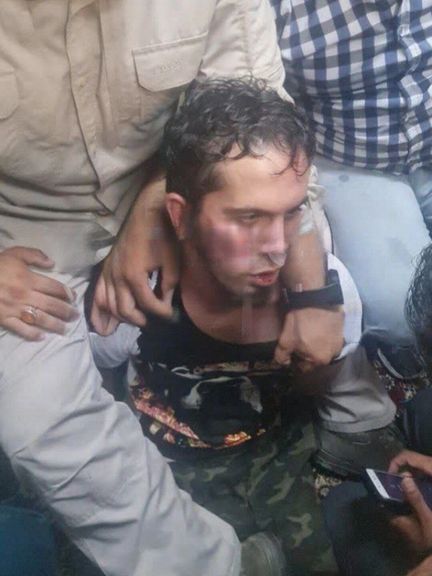
The regime’s state broadcaster announced that the Islamic State group (ISIS) has claimed responsibility for the attack, but so far there is no evidence of any statement by the terror group.
In last year's attack when 15 people were killed at Shahcheragh, the Islamic State claimed responsibility. The militant group, which has claimed other attacks in Iran -- including the deadly twin bombings in 2017 that targeted Iran's parliament and the tomb of the Islamic Republic's founder Ruhollah Khomeini – has played the role of boogeyman in regime’s narratives of regional developments to justify its military presence and support of other foreign militias, and strict security atmosphere inside the country.
A large number of regime officials, including parliament speaker Mohammad-Bagher Ghalibaf, Foreign Minister Hossein Amir-Abdollahian and President Ebrahim Raisi as well as several lawmakers and military commanders, vowed revenge against those behind the attack.
In a vague remark, Foreign Ministry spokesman Nasser Kanaani said, “The attack on worshippers is a heinous act of vengeance in response to the significant blows that Iran dealt on terrorists in the battlefields.” The governor of Fars province, Mohammad Hadi Imaniyeh, attributed the motive of the assailant to "vengeance" for the execution of two individuals involved in last year's attack.
In July, Iran publicly hanged two Afghan men who were accused of "providing weapons, procurements, logistics, and guidance of the main perpetrator", which bears uncanny resemblance to the Sunday shooting. The lone gunman, armed with an assault rifle, entered the shrine last October and opened fire, and was subsequently shot and later died in hospital. He was also identified as a Tajikistan citizen. The October attack coincided with anti-regime protests in Iran. This prompted speculation and accusations that the government orchestrated the incident as a diversion from the protests and as a pretext for further crackdown.
Within the Iranian social media sphere, opinions diverge on how to respond to the attack, with some holding the regime accountable for either incompetence or possible involvement, while others echo the regime's stance in condemning the extremists.
A large number of people criticize the regime for focusing its forces and surveillance methods for cracking down on women who refuse to wear the hijab, rather than real criminals. Additionally, some speculate that this attack was orchestrated to divert public attention away from the ongoing political debate regarding the enforcement of new hijab laws, currently undergoing final deliberations in parliament.
In the lead-up to the anniversary of last year's nationwide anti-regime protests in September, Iranian authorities have heightened security measures, resorting to intimidation and threats in an attempt to prevent public demonstrations. Some believe that the attack on Shahcheragh was orchestrated to provide a pretext for tighter security measures.